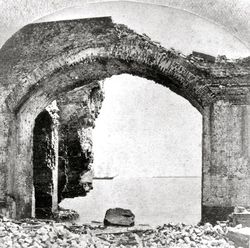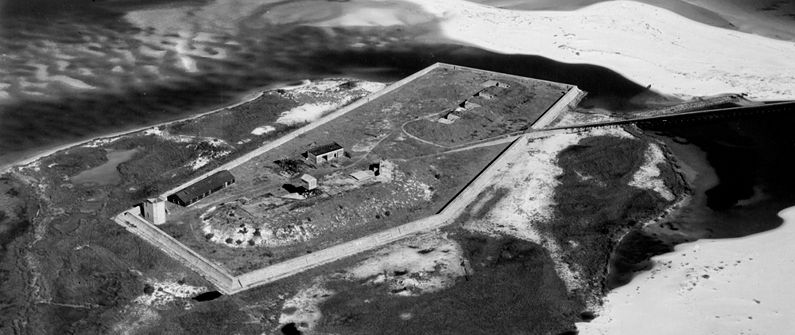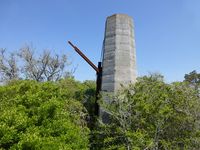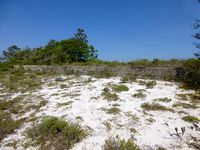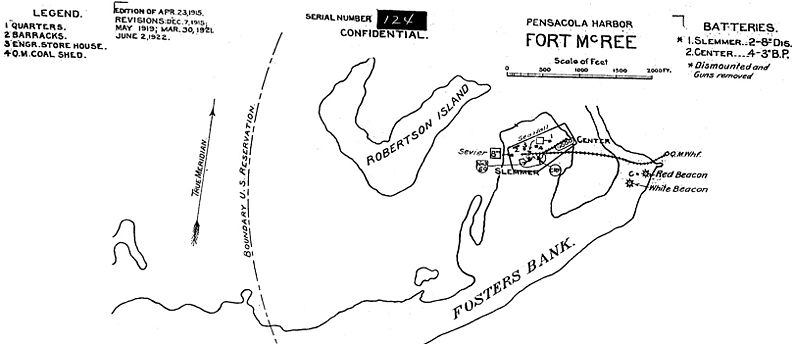Fort McRee
|
Fort McRee (1834-1947) - Constructed between 1834-1839 as a Third System brick, three tiered fort with an outlying water battery on Foster Bank, Pensacola, Escambia County, Florida. Named for Bvt. Colonel William McRee in April 1840. Additional gun batteries were added during the Endicott Period and World War II. Fort McRee was deactivated in 1947 and transferred to the Navy. History of Fort McReePart of the Harbor Defense of Pensacola. After the Mexican War Fort McRee, Fort Barrancas and Fort Pickens were garrisoned only during drills, maneuvers and target practice from the barracks at Fort Barrancas, this continued up to the start of the U.S. Civil War. U.S. Civil War (1861-1865)In January 1861, just before the start of the U.S. Civil War, 1st Lt. Adam J. Slemmer and the 50 men under his command were forced to abandon Fort Barrancas and Fort McRee to secessionists of the Florida and Alabama militia. Lt. Slemmer and his men spiked the guns at Fort Barrancas and Fort McRee and removed to Fort Pickens where they were reinforced by additional Union forces. In May 1862 Confederate forces abandoned all of the Pensacola area fortifications and they remained under Union control for the remainder of the war. Fort McRee was almost destroyed in the Federal bombardment and was not rebuilt. After the war, the bricks from Fort McRee were used in the reconstruction of other buildings and the old fort deteriorated even further. Endicott Period (1890-1910)Construction began on the first of two concrete Endicott Period gun batteries in 1898, on a site west of the old brick fort. The second battery was started in 1899. Both batteries were completed and accepted for service by 1901. Protection against gulf storms was improved in 1904 with the placement of additional riprap and protective groins. A killer hurricane struck the post in September 1906 with 85 miles per hour winds and a surge 12' above the normal high tide, covering Fosters Bank. Several military members and several dependents were swept away and lost their lives. Survivors were forced to cling to rooftops and a disintegrating water tank overnight. Battery Center had damage to three of the four gun emplacement, emplacement #4 had to be rebuilt and the others were repaired. The engineers took the opportunity to expand Battery Center and move the emplacements further apart. The rework of Battery Center was completed in 1910. The hurricane made it clear that the riprap and groins were not enough protection for the batteries or the personnel. In 1908 a seawall was proposed and approved for the area around the Endicott Period batteries. The seawall was to be 11' high with a width at the bottom of 13' and a width of 5' at the top. That seawall can be seen in the aerial photo above. The cost of the seawall at Fort McRee was estimated at $240,000 and came to completely enclose both batteries and the support structures. The seawall project was completed in May 1911.
World War IBattery Slemmer's guns were removed for service abroad in March 1918 and one of the guns actually made it to France before the end of the war, the other gun did not. Battery Slemmer was not rearmed but a C.R.F. station was placed in emplacement #2 and a searchlight was placed in emplacement #1. Battery Center's guns were removed in 1920 and returned to the Watervliet Arsenal.
World War II (1941-1945)Battery 233, a single battery of two 6" guns, was begun at Fort McRee in 1943 but, by the end of the war, it still did not have the gun tubes installed and was never armed.
Current StatusPart of the Gulf Islands National Seashore on Perdido Key. Open access to all of the Fort McRee area but Battery 233 is locked up so there is normally no internal access to the interior rooms. The ruins of Battery Center and Battery Slemmer can be seen but are mostly buried in sand. Normal access is by boat but it is possible to hike along Perdido Key to the fort site. The fort is about five miles from the end of the nearest park road. No period guns or mounts in place.
Recent Blog Posts: Sources:
Links: Visited: 26 Apr 2013
| |||||||||||||||||||||||||||||||||||||||||||||||||||||||||
- Harbor Defense of Pensacola
- Visited
- All
- Florida All
- Florida Forts
- Florida Escambia County
- Third System Forts
- Coastal Forts
- U.S. Civil War Forts
- Endicott Period Forts
- World War I Forts
- World War I Coastal Forts
- World War II Forts
- World War II Coastal Forts
- Fort McRee
- National Seashore
- 2013 Research Trip
- CDSG Conference 2013

